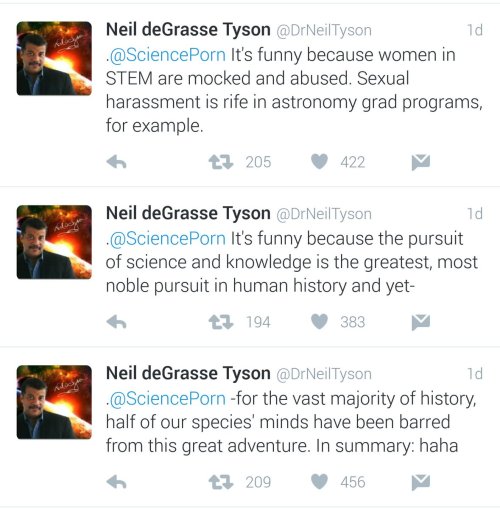Ever Have To Talk To An #evolution Denier? Seems That This Is Usually How It Goes.

Ever have to talk to an #evolution denier? Seems that this is usually how it goes.
More Posts from Scistrike-blog and Others
Solar System: Things to Know This Week
There’s even more to Mars.

1. Batten Down the Hatches
Good news for future astronauts: scientists are closer to being able to predict when global dust storms will strike the Red Planet. The winds there don’t carry nearly the same force that was shown in the movie “The Martian,” but the dust lofted by storms can still wreak havoc on people and machines, as well as reduce available solar energy. Recent studies indicate a big storm may be brewing during the next few months.
+ Get the full forecast

2. Where No Rover Has Gone Before
Our Opportunity Mars rover will drive down an ancient gully that may have been carved by liquid water. Several spacecraft at Mars have observed such channels from a distance, but this will be the first up-close exploration. Opportunity will also, for the first time, enter the interior of Endeavour Crater, where it has worked for the last five years. All this is part of a two-year extended mission that began Oct. 1, the latest in a series of extensions going back to the end of Opportunity’s prime mission in April 2004. Opportunity landed on Mars in January of that year, on a mission planned to last 90 Martian days (92.4 Earth days). More than 12 Earth years later, it’s still rolling.
+ Follow along + See other recent pictures from Endeavour Crater

3. An Uphill Climb
Opportunity isn’t the only NASA Mars rover getting a mission extension. On the other side of the planet, the Curiosity rover is driving and collecting samples amid some of the most scenic landscapes ever visited on Mars. Curiosity’s two-year mission extension also began Oct. 1. It’s driving toward uphill destinations, including a ridge capped with material rich in the iron-oxide mineral hematite, about a mile-and-a-half (two-and-a-half kilometers) ahead. Beyond that, there’s an exposure of clay-rich bedrock. These are key exploration sites on lower Mount Sharp, which is a layered, Mount-Rainier-size mound where Curiosity is investigating evidence of ancient, water-rich environments that contrast with the harsh, dry conditions on the surface of Mars today.
+ Learn more

4. Keep a Sharp Lookout
Meanwhile, the Mars Reconnaissance Orbiter continues its watch on the Red Planet from above. The mission team has just released a massive new collection of super-high-resolution images of the Martian surface.
+ Take a look

5. 20/20 Vision for the 2020 Rover
In the year 2020, Opportunity and Curiosity will be joined by a new mobile laboratory on Mars. In the past week, we tested new “eyes” for that mission. The Mars 2020 rover’s Lander Vision System helped guide the rocket to a precise landing at a predesignated target. The system can direct the craft toward a safe landing at its primary target site or divert touchdown toward better terrain if there are hazards in the approaching target area.
+ Get details
Discover the full list of 10 things to know about our solar system this week HERE.
Make sure to follow us on Tumblr for your regular dose of space: http://nasa.tumblr.com
State of NASA
Over his tenure, President Obama has now invested $147 billion in America’s space program. Our elected leaders, on a bipartisan basis, have chosen to make this investment in our Agency, because they believe in our Journey to Mars and recognize that investments in NASA’s present are investments in America’s future.
Because the State of our NASA is strong, President Obama is recommending a $19 billion budget for the next year to carry out our ambitious exploration and scientific discovery plans. Here are the areas in which we’ll continue to invest:
Solar System and Beyond

As we explore our solar system and search for new worlds, we look to answer key questions about our home planet, neighboring planets in our solar system and the universe beyond.
Journey to Mars

We’re developing the capabilities needed to send humans to an asteroid by 2025 and Mars in the 2030s. Mars is a rich destination for scientific discovery and robotic and human exploration as we expand our presence into the solar system. Its formation and evolution are comparable to Earth, helping us learn more about our own planet’s history and future.
International Space Station

Earth Right Now

We use the vantage point of space to increase our understanding of our home planet, improve lives and safeguard our future. Our Earth science work also makes a difference in people’s lives around the world every day.
Technology Drives Exploration

Sustained investments in our technology advance space exploration, science and aeronautics capabilities. We seek to improve our ability to access and travel through space; land more mass in more locations throughout our solar system; live and work in deep space and on planetary bodies; build next generation air vehicles, and transform the ability to observe the universe and answer profound questions in Earth and space sciences.
Aeronautics

Thanks to advancements in aeronautics developed by NASA, today’s aviation industry is better equipped than ever to safely and efficiently transport all those passengers to their destinations.

The President’s FY 2017 budget provides $790 million to our Aeronautics Research Mission Directorate. This investment will accelerate aviation energy efficiency, advance propulsion system transformation and enable major improvements in aviation safety and mobility. The future of flight will: utilize greener energy, be half as loud, use half the fuel and will create quieter sonic booms.
State of NASA Social

Today, we have opened our doors and invited social media followers and news media to an in-person event, at one of our 10 field centers. Guests will go on a tour and see highlights of the work we’re doing. You can follow along digitally on Twitter: https://twitter.com/NASASocial/lists/state-of-nasa-all1.
Check our Twitter Moment HERE.
Did you miss NASA Administrator Bolden’s remarks? You can watch a full recap HERE.
For all budget related items, visit: http://www.nasa.gov/news/budget/index.html
Make sure to follow us on Tumblr for your regular dose of space: http://nasa.tumblr.com
Watch as NASA Test-Fires the RS-25 Rocket Engine
NASA test-fired an RS-25 rocket engine today, 08/18/2016 at the Stennis Space Center in Bay St. Louis in Mississippi. The RS-25 is one of four modified space shuttle main engines that will help lift the huge SLS rocket off the ground assisted by two solid rocket boosters.* The RS-25 engines are fueled by liquid oxygen and liquid hydrogen. Combined, the four RS-25 engines on SLS will generate 2…
View On WordPress




How Exactly Do We Plan to Bring an Asteroid Sample Back to Earth?
Our OSIRIS-REx spacecraft launches today, and will travel to a near-Earth asteroid, called Bennu. While there, it will collect a sample to bring back to Earth for study. But how exactly do we plan to get this spacecraft there and bring the sample back?

Here’s the plan:
After launch, OSIRIS-REx will orbit the sun for a year, then use Earth’s gravitational field to assist it on its way to Bennu. In August 2018, the spacecraft’s approach to Bennu will begin.

The spacecraft will begin a detailed survey of Bennu two months after slowing to encounter the asteroid. The process will last over a year, and will include mapping of potential sample sites. After the selection of the final site, the spacecraft will briefly touch the surface of Bennu to retrieve a sample.

To collect a sample, the sampling arm will make contact with the surface of Bennu for about five seconds, during which it will release a burst of nitrogen gas. The procedure will cause rocks and surface material to be stirred up and captured in the sampler head. The spacecraft has enough nitrogen to allow three sampling attempts, to collect between 60 and 2000 grams (2-70 ounces).

In March 2021, the window for departure from the asteroid will open, and OSIRIS-REx will begin its return journey to Earth, arriving two and a half years later in September 2023.

The sample return capsule will separate from the spacecraft and enter the Earth’s atmosphere. The capsule containing the sample will be collected at the Utah Test and Training Range.

For two years after the sample return, the science team will catalog the sample and conduct analysis. We will also preserve at least 75% of the sample for further research by scientists worldwide, including future generations of scientists.
The Spacecraft

The OSIRIS-REx spacecraft is outfitted with some amazing instruments that will help complete the mission. Here’s a quick rundown:
The OCAMS Instrument Suite

PolyCam (center), MapCam (left) and SamCam (right) make up the camera suite on the spacecraft. These instruments are responsible for most of the visible light images that will be taken by the spacecraft.
OSIRIS-REx Laser Altimeter (OLA)

This instrument will provide a 3-D map of asteroid Bennu’s shape, which will allow scientists to understand the context of the asteroid’s geography and the sample location.
OSIRIS-REx Thermal Emission Spectrometer (OTES)

The OTES instrument will conduct surveys to map mineral and chemical abundances and will take the asteroid Bennu’s temperature.
OSIRIS-REx Visible and Infrared Spectrometer (OVIRS)

This instrument will measure visible and near infrared light from the asteroid. These observations could be used to identify water and organic materials.
Regolith X-Ray Imaging Spectrometer (REXIS)

REXIS can image X-ray emission from Bennu in order to provide an elemental abundance map of the asteroid’s surface.
Touch-and-Go Sample Arm Mechanism (TAGSAM)

This part of the spacecraft will be responsible for collecting a sample from Bennu’s surface.
Watch Launch and More!

OSIRIS-REx Talk Wednesday, Sept. 7 at noon EDT Join us for a discussion with representatives from the mission’s science and engineering teams. This talk will include an overview of the spacecraft and the science behind the mission. Social media followers can ask questions during this event by using #askNASA. Watch HERE.
Uncovering the Secrets of Asteroids Wednesday, Sept. 7 at 1 p.m. EDT During this panel, our scientists will discuss asteroids, how they relate to the origins of our solar system and the search for life beyond Earth. Social media followers can ask questions during this event by using #askNASA. Watch HERE.
LAUNCH COVERAGE!
Thursday, Sept. 8 starting at 4:30 p.m. EDT Watch the liftoff of the United Launch Alliance’s (ULA) Atlas V rocket from Kennedy Space Center in Florida at 7:05 p.m. Full coverage is available online starting at 4:30 p.m. Watch HERE. We will also stream the liftoff on Facebook Live starting at 6:45 p.m. EDT. Watch HERE.
Make sure to follow us on Tumblr for your regular dose of space: http://nasa.tumblr.com

Orbital ATK Antares Rocket Returns to Flight (Full Video)
Orbital ATK Antares Rocket Returns to Flight (Full Video)
The Orbital ATK Antares rocket returned to flight on October 17th with a launch from NASA’s Wallops Flight Facility in Virginia. I was on-site to witness and document the event for Science Strike Force as part of the NASASocial program. The attached video is one of the results.
The launch was actually scheduled for the previous evening, but an underperforming ground cable (not part of the Antares…
View On WordPress

The 363-foot-tall Apollo 12 Saturn V rocket rolls out of the Vehicle Assembly Building at Cape Canaveral, September 8, 1969. (NASA)
Our friend Deverick Wimbush, quite the fan of science, is TRYING to debunk a Flat Earth nutter, but meeting with only dishonesty and evasiveness. Apparently, he's had about enough of it. (Some strong language)
Exposing the misinformation of science-deniers, moon-hoaxers, flat-earthers and the rest of the tinfoil hat wearing crowd at www.sciencedenierhallofshame.com
99 posts